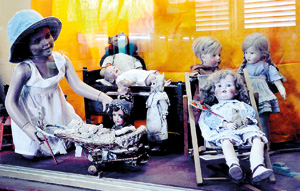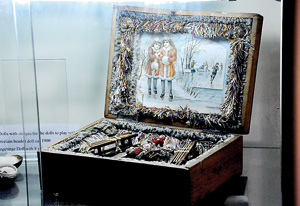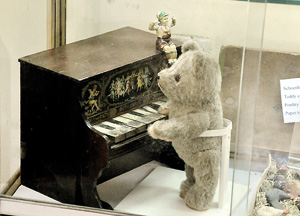If there’s one thing we all share, it’s a collective memory of a childhood spent bridging our imagination and our toys; those are memories that never fade. Stepping into the German Toy Museum on Havelock Road, you’re literally swept back to those magical days. The place has a timeless feel, complemented by the proprietor herself, Gayangi von Heimendahl who explains that every single toy in her collection has a history.
 |
| Gayangi von Heimendahl |
“They’ve always been something quite special to me and my husband,” Gayangi says. “And you know toys are something that every human being has in common. Every single one of these toys come with a little piece of history attached to it. Some stories are worth generations. Each toy has been used by little children for years, passed down from generation to generation.”
The von Heimendahl collection has been 35 years in the making. Gayangi, who met and married her husband Prof. Dr. Manfred von Heimendahl in Germany, would go with him to collectors’ shops in search of ‘0 scale’ train models, a fascination for him.
One such visit led to the owner selling them some of the very few duplicates that he had, and what started off as a hobby eventually became a passion, with the couple visiting flea markets, auctions and even castles in search of the next perfect addition to an already growing collection.
“Eventually, the toys took over our house,” she laughs, ‘We had to move them out, somehow. So in 1990, we opened a small gallery called Spielzeugmuseum (toy museum) Reit im Winkl (a city bordering Austria), which we ran for five years.
Then we established a partnership with the city of Traunstein (in South-eastern Baveria) and opened Spielzeug- und Stadtmuseum Traunstein (Toy and City Museum of Traunstein), which we’ve been running since. Half our collection is over there, and the rest is here.”
The toys on exhibit are beautifully preserved, albeit with minute signs of wear and tear that tell you the toy was once a child’s precious possession. The collection covers a range -from dolls, miniature models of places, wind-up toys, toy cars, puzzles, cards, marbles and much more.
These toys also reflect the era they were made in. A miniature till from the 1930s is made in the shape of a drum, a famous symbol of Hitler’s soldiers. A model of a grocery store from the 1930s comes complete with ration cards, a sign of wartime. A replica of a lady’s chambers from the 1800s represents the femininity and fashions of the Victorian era with an attention to detail that can hold you transfixed.
A stable house made in the same era represents the modes of dress worn by different classes of society, and miniature kitchens from the period will even let you cook miniature food on them, using utensils very much different to those used today. Toy cars are in a class of their own; bright colours and sharp designs speak of a time when vehicles were a luxury item.
Dolls of all sizes and make feature prominently in the collection. Very few are made of plastic or fabric, instead, they come in porcelain, papier mache, ceramic, wax, metal, and composite figurines, dressed in all manner of clothes depending on the era they were made in.
The porcelain ones are beautifully fragile. “Toys were something precious for kids in those times. They looked after them with a lot of care,” explains Gayangi. A model of a toy shop is crammed with ‘penny toys’, a popular craze of that era, with those being the cheapest you could buy. The toy shop is inscribed with ‘Christmas 1926’, presumably by a delighted child on opening her Christmas present.
Attention to detail is everywhere you look. Each toy, irrespective of size or material, is carefully designed, with great attention to even the most minor feature. The Germans were famous for their toys, mass manufacturing them since the 1800s.
The earliest dolls were carved out of sticks of wood, sometimes made by mothers for their children. Often, newspapers would come with instructions for creating playhouses and other toys, which parents would assemble for their children as a token of love. Gayangi mentions that children were often gifted with large toys for Christmas and in January, they would be taken away and put in boxes, only to be brought out the next Christmas, as it was believed that children grew tired of one toy after a certain time.
Gayangi plans to add a range of puppets to the museum, which she has already acquired. Travelling often to Germany, where she is part of a large network of collectors, she says makes it easier to acquire them at good value.
Gayangi’s purpose for the museum is clear. “The move back here was inevitable - this is where I was born and bred. This, for me, is home. I opened this museum because I believe that when you have a collection like this, it’s important that you share it with people. I want the people in Sri Lanka to experience the joy of these toys, and learn about another culture. Hopefully even create toys for their own children. Playing is so much like meditation. If you can get lost in something like that, then you’ll do very well in life.”
The German Toy Museum is not just entertainment; it’s a revelation. One wouldn’t expect a ‘mere’ toy to tell a story; but each of these pieces, each little wooden figurine and handmade dolls’ house has a life of its own. It’s a story woven through decades of play by countless little children, and it’s a story that continues to be told with their exhibition at the museum.
The German Toy Museum is open daily from 10 a.m. to 6 p.m. at No. 421, Havelock Road, Colombo 6. |





